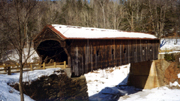Upper Falls Covered Bridge |
|
|
Site: V08-8 |
National Register Nomination Information:
DESCRIPTION: The Upper Falls Covered Bridge consists of a single span supported by two flanking timber Town lattice trusses. At each corner of the bridge, a wood buttress inclines inward from an extended floor beam to the upper side of the truss. Intended to give lateral support to the superstructure, these buttresses have largely rotted away, and the superstructure leans eastward especially toward the north end. The southern end of the bridge rests on its original abutment of stone slabs; the northern abutment has been either rebuilt or faced wlth concrete. The Upper Falls bridge is 120 feet long at the bottom of the trusses, with a gable overhang of 4 feet at each end. The bridge is 18.5 feet wide, with a 15-foot roadway. On the exterior, the large planks pegged together diagonally to form the trusses (and side walls) of the bridge are sheathed with flush boards hung vertically. Many of these boards are missing, especially on the east side and near the portals. There are no windows or intentional openings in the siding. The gables are pedimented with a partial cornice return, several components of which are missing. The gables are sheathed with flush horizontal boards. The roof is covered with corrugated metal sheeting.
The Upper Falls Covered Bridge, with its pedimented gables, represents the pervasive influence of the Greek Revival style on rural Vermont building art in the latter 19th century. The style arrived later and remained fashionable longer in Vermont than in most other parts of the country. It appeared in many structures other than houses, with the Upper Falls bridge (wnich probably dates from about 1870) demonstrating its application to bridge design. The southern abutment of the Upper Falls bridge is an outstanding example of massive dry laid stonework. The stone slabs are laid up into smooth faces with precise corners. The abutment is unusually long and high, intended to carry the bridge well above flood stage of the Black River. The covered bridges of Vermont are among its most cherished and symbolic historic resources. About one hundred bridges still stand in the state, the greatest concentration by area of covered bridges in the country.(1) Many of these bridges are integral parts of unique architectural environments whose physical setting and cultural context have been little altered until recently. Now, however, pervasive highway expansion, intensive commercial development, and physical neglect are changing drastically the historic environment and threatening the covered bridges. The Vermont Division of Historic Sites, therefore, wishes to extend the recognition and protection of the National Register to the majority of the surviving covered bridges, including the Upper Falls bridge. (1) R. S. Allen, Covered Bridges of the Northeast, The Stephen Greene Press, Brattleboro, Vt., 1957, p. 50.
Allen, Richard Sanders, Rare Old Covered Bridges of Windsor County, The Stephen Greene Press, Brattleboro, Vt., 1962. Allen, Richard Sanders, Covered Bridges of the Northeast, The Stephen Greene Press, Brattleboro, Vt., 1957.
DATE ENTERED: August 28, 1973.
|
BACK TO NATIONAL REGISTER PROPERTIES
